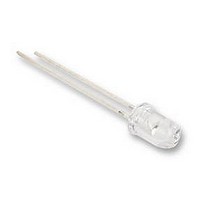LED3-UV-400-30 Bivar Inc, LED3-UV-400-30 Datasheet - Page 3

LED3-UV-400-30
Manufacturer Part Number
LED3-UV-400-30
Description
UV LED, 3MM, 30DEG
Manufacturer
Bivar Inc
Datasheet
1.LED3-UV-400-30.pdf
(9 pages)
Specifications of LED3-UV-400-30
Bulb Size
T-1 (3mm)
Led Colour
Blue
Luminous Intensity
12mcd
Viewing Angle
30°
Forward Voltage
3.7V
Led Mounting
Through Hole
Lens Shape
Round
Wavelength Typ
400nm
External Diameter
3.8mm
External Length
RoHS Compliant
Forward Current If
20mA
Rohs Compliant
Yes
Ultraviolet radiation (UV) is only a small portion of the radiation we receive from the
sun, but has a large impact on all biological activity here on Earth. BivarOpto solid state
UV emitters can produce up to 12mW of 400nm UVA radiation for specialized
applications that in the past relied upon large high-voltage incandescent/filament lamps.
We have provided special cautions for users in order to avoid miss-use. Prolonged
exposure or miss-use of any UV light source carries with it some potential health risks.
Physical Definition
All radiation from our sun travels in the form of electromagnetic waves and is
characterized as solar (originating with the Sun) radiation. Solar Radiation is measured in
terms of wavelength with is the distance between two points of identical phase in a
successive cycle of the wave and expressed in nanometers, one-billionth of a meter.
Wavelengths just short of the visible spectrum (410nm-790nm) are classified as
Ultraviolet (UV). UV is defined as all radiation between 100 and 400nm. Although there
are other sources of UV radiation, such as welding arcs, incandescent lamps and LEDs,
most UV Radiation that you will come in contact with is from our sun.
The UV portion of daylight accounts for less than 10% of the total energy output from
our sun and the majority of this is absorbed or scattered back into space by the protective
shield of our atmosphere. This results in very little UV radiation actually reaching the
surface of the Earth.
Ultraviolet radiation is classified in three groups:
UV Effects
UV has a variety of effects on plants, animals, and materials here on Earth and frankly,
most of them aren't good. UV is known to negatively affect commonly used materials
such as plastics that we rely on to provide us everything from lighter cars to cheap lawn
furniture. While stratospheric and tropospheric chemistry finds UV its main catalyst, the
majority of UV's effects that have been studied involve the impact of UV on general
biology. These effects can range from human health impacts to impacts on single cell
organisms. Underlying many of these studies is the fact that each UV photon has more
energy than most other photons normally encountered in nature. UV wavelengths,
particularly those in the UVB range, can efficiently break DNA bonds. While some
studies have shown that UVA, can actually assist in repairing some forms of DNA
damage. The one thing for sure it that the shorter the wavelength the greater and more
damaging are the potential effects.
UVA 320-400nm: the most prevelant form of UV Radiation (and the dominant
wavelength of BivarOpto UV LEDs)
UVB 280-320nm: most of this energy is absorbed in our atmosphere. UVB can be
generated with incandescent sources and has medical (germicidal) applicaitons.
UVC 100-280nm: nasty radiation and very little of it reaches the Earth's surface.
(protect that ozone layer or we will all be growing extra limbs and learning to live
in caves again!)
Understanding a little more about UV




















